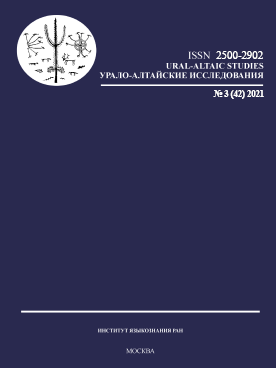ПЕРВЫЙ ЧЕРЕМИССКИЙ СЛОВАРЬ — АРХАИЧЕСКИЙ ТЕКСТ ИЛИ КОНКОРДАНС СЛОВ ИЗ НЕСКОЛЬКИХ МАРИЙСКИХ ДИАЛЕКТОВ? (О. А. СЕРГЕЕВ. ВАСИЛИЙ КРЕКНИН, ИОАНН ПЛАТУНОВ «КРАТКОЙ ЧЕРЕМИСКОЙ СЛОВАРЬ С РОССИЙСКИМ ПЕРЕВОДОМ»: ЛИНГВИСТИЧЕСКИЙ АНАЛИЗ (С ПРИЛОЖЕНИЕМ СЛОВАРЯ).
THE FIRST MARI DICTIONARY — AN ARCHAIC TEXT OR CONCORDANCE OF THE WORDS FROM DIFFERENT MARI DIALECTS? (O. A. SERGEEV. VASILIY KREKNIN, IOANN PLATUNOV “A SHORT MARI DICTIONARY WITH RUSSIAN TRANSLATION”: A LINGUISTIC ANALYSIS (SUPPLIED WITH A DICT.)
Author(s): Julia V. NormanskajaSubject(s): Cultural history, Theoretical Linguistics, Phonetics / Phonology, Historical Linguistics, Finno-Ugrian studies, Book-Review
Published by: Институт языкознания Российской академии наук
Keywords: Mari dialects; chronology of the dialect’s changes; first books; graphics; phonetics;
Summary/Abstract: This review analyzes the ways in which the Concise Cheremis-Russian Dictionary differs from the literary Mari language in order to answer the following question: was the dictionary compiled in the Pizhan subdialect of the Yaransk dialect of Northwestern Mari, which was spoken at that time in the Kukarskaya Sloboda, where the dictionary was created, or, as O. A. Sergeev claims, “words belonging to all the main dialects of the modern Mari language can be found in the Concise Cheremis-Russian Dictionary” [Сергеев 2020: 17]? To answer this question, a comprehensive graphic-phonetic analysis of the dictionary has been carried out. Three innovative features inherent in the Yaransk dialect have been identified (PMari *ć > ц, PMari *-j > 0, PMari *ńč́, *ńʒ́, *nǯ > нз) together with five more features that are characteristic of other first books: the preservation of the PMari *i, the reflection of PMari *ӧ as o and PMari *w as b, and the retention of vowel harmony. The only feature that occurs neither in the nineteenth-century books, nor in the modern dialects is the PMari *ӧ > е/э, which may indicate a later origin of Mari ӧ < Finno-Ugric *е than previously thought. Thus, the review shows that the dictionary could have been written in the Pizhan subdialect of the Yaransk dialect, which differed significantly from its modern state in the 18th century as it retained many archaic features characteristic of other first books. The analysis of the dictionary allows one to refine the history of the Yaransk dialect and the dating of certain sound changes.
Journal: Урало-алтайские исследования
- Issue Year: 2021
- Issue No: 03 (42)
- Page Range: 90-99
- Page Count: 10
- Language: Russian

